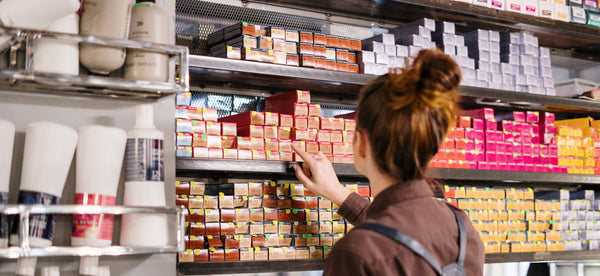Towards Zero Packing Errors: Packwise
Together with PLINT, we have a mission to reduce pick & pack errors to zero.
We are SUPER excited to share with you, our solution to reducing picking errors to a mere zero, at a fraction of the cost of a warehouse management system. Together with, and in close collaboration with our long time client, PLINT, we are developing a solution that anyone can benefit from.
This is how we are doing it…
Identifying the problem
In a regular monthly evaluation (this one about BFCM 2019 performance) we found that as sales grew, so did picking and packing errors, resulting in more returns and costs.

As it turns out, industry wide, the average picking error rate is between 1% and 3%, costing between $50 to $300 per order, resulting in an 11-13% drain in profitability.
With 1.000 monthly orders, that may amount to +/- $42.000 per year, it is a significant cost for small and medium sized companies.
For PLINT, the picking error rate for their B2C branch hovered around 2%, whereas the B2B branch hovered around 8-10%, exacerbating the problem significantly.
Process implications
Generally, returns are a hassle, but when they are due to packing errors, it’s even worse. A picking error may involve some, or all, of the below processes:
-
Retention.Customers receiving the wrong product are less likely to purchase again. Picking errors have a direct impact on the potential lifetime value of new or existing customers.
-
Customer service.It takes time for the customer and company to situate and execute the return. Both documentation and communication forth and back.
-
Returning the product.If you offer free returns it is even more costly. It may include issuing new shipping labels, shipping costs, receiving and restocking.
-
Repacking the product.Picking and packing into new boxes, package fillings, brochures and information, etc. - unless existing ones can be reused of course (remember the environment).
-
Reshipping (hopefully). Printing the third shipping label.
-
Time and labour. The time spent on packing, communicating, restocking, repicking and repacking are all labour intensive and takes time from handeling other orders.
The packing process - status quo
To avoid packing errors, PLINT had attempted several solutions ranging from double checking all orders, pick & pack lists, team review, “zero-talking packing time”, and other more or less (un)successful initiatives. None of which removed the packing errors entirely.
Packing at PLINT follows a two-step process.

-
Picking. The picker takes a cart with trays for order collection. The picker picks orders according to their picklists and places the products on the respective trays. When the cart is full, the picker returns the cart to the packing station. The picker takes an empty cart and repeats the process.
-
Packing. The packer receives the cart and takes a tray with an order. Each order is checked according to the list and packed carefully into a shipping box. A label is printed, and the shipment is forwarded to the pickup point.
Towards zero packing errors
We first looked at the picking process. Mobile picking scanners were deemed error prone. With the picker surrounded by orders, products, other boxes and colleagues, the scanners caused confusion. More time was spent checking that the right products were scanned and collected opposed to actually picking. Even so, errors happened when the picker accidentally placed a product on the wrong tray.
So, we changed focus to the packing process. The packer handles one order at a time. Our solution was to develop a simple piece of software that collects the order the packer is packing and match the order items with the products being packed.
The packer scans a product and puts it into the shipping box. Any discrepancies between the ordered products and the ones being scanned are voiced by the system, and the error can be corrected.

The solution was rather simple. However, it instantly reduced the packing errors to a fraction of what it was.
We found that the last process before the order is shipped is where the last quality control should be. It removes any possibility of products being removed, exchanged or confused as the box is instantly sealed following the order being successfully packed.
Moving forward
The system has been operating and running locally on their computers over the past year. In the meantime, we have been busy perfecting the software according to the feedback we got (and still is getting) from PLINT and from their customers.

Today, PLINT has zero packing mistakes. What is more, they can track which products goes into which boxes (when processing a larger B2B order), automatically fulfill or partially fulfill orders back into Shopify based on the scanned items. They can print and forward a detailed packing confirmation PDF to their customers, write messages directly from the packing station to the order (e.g. if anything is consciously missing), and much, much more.
The interface has been updated significantly from a local “windows 95” version to a fully cloud hosted solution that integrates seamlessly with Shopify and any major online eCommerce platform.
It can be operated from a computer like PLINT's does, or with a tablet (or smartphone) and a bluetooth barcode scanner.
We are SUPER excited to share more with you about - what we are now calling - Packwise, and its development towards helping merchants reaching zero packing errors. We will be working at launching it as a ready-to-install app for all Shopify users in the coming months, but it is also available to any other major eCommerce platform.
You can see the early software presentation at www.pack-wise.com
If you are curious as to how this is working or how you may be using it, feel free to reach out anytime. You can contact me through mail@call-houston.com.

Also in Knowledge

Colour palette choices with Canva
Canva is a great platform for creating graphics and visual content. Within all that Canva offers, there is a set of tools that can support you in your website and graphics development within the choice for colours. We present you 5 ways in which Canva can support you while choosing a colour palette.

eCommerce trends for 2020


Sigurd Tranaes
Founder of Call Houston.In our team, Sigurd focus on business development in eCommerce and omni-channel.You will find him anywhere with his laptop, or hyper-excited for whatever new thing has grasped his attention.